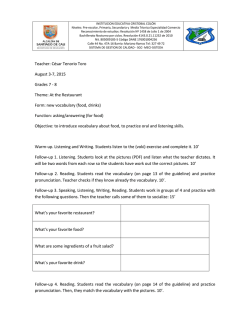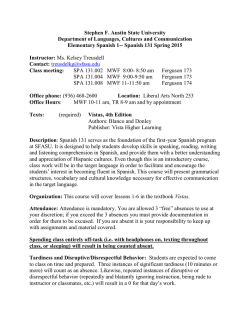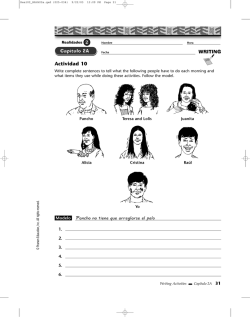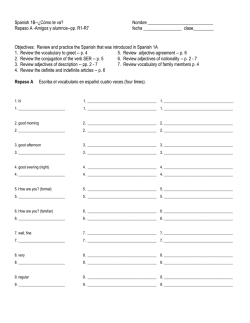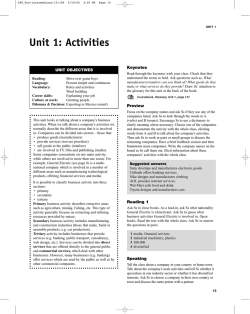
Unit 1: Contacts
M01_INBU_TB_ELEGLB_9784_CU1_6.qxd 10/4/08 12:38 Page 15 UNIT 1 Unit 1: Contacts UNIT OBJECTIVES Reading: Vocabulary: Career skills: Dilemma & Decision: Working in a foreign country Language: to be Countries and nationalities; jobs Introducing yourself Who to interview? as: How do you greet someone in English? What is your first name? What is your surname? If your students are in work you could also ask if they have business contacts in different countries and what their job title is. This is a good opportunity to introduce Ss to the glossary for this unit at the back of the book. Focus on the words from the Keynotes in the glossary. Try to elicit the meaning of the following: n (noun), (C) (countable noun), v (verb), adj (adjective). Coursebook, Glossary, Unit 1, page 150 This unit looks at situations where business people meet new contacts. This can happen in many situations, such as meetings, presentations, conferences and training courses. When making initial contact, it is often necessary to ask and answer basic questions about your name, company and nationality. Much of this information is also included on business cards. But, depending on the country, business cards can carry far more cultural significance than the basic personal details noted on them. In Europe and the USA, business cards are often treated casually – they can be slipped into pockets without being read. However, in many other cultures business cards have greater importance and should be treated with respect, for example in Japan and China. It is always a good idea to research how and when business cards are presented in the country you are visiting (for example, at the beginning or end of a meeting?). If you are in a situation where you are unsure of specific business card etiquette, make a point of reading and commenting on the card when you are given it. Business cards are an invaluable internationally recognised tool when meeting new contacts and it is a good idea to have a plentiful supply. When travelling abroad on business, it is also a good idea to have the information printed in the language of the country you are visiting on one side of the card. Keynotes Before opening books write Global business on the board. Check Ss understanding and ask them to brainstorm the names of companies that have offices in different countries (for example ICI, Coca cola, Nokia, HSBC – check to see if Ss know what these companies do/make/sell etc). Open books and read through the keynotes with your class. Check that they understand the words in bold. Ask questions such Preview Before opening books, show Ss your own business card or ask Ss if they have a business card. Elicit what it is. Get Ss to brainstorm what information we usually find on a business card. 1 Open books and focus Ss on the example in exercise 1. In pairs or individually, ask Ss to match the words in the box with items 2–6 on the business card. Have a brief feedback session to check answers. You may also wish to ask Ss to name other famous companies and common qualifications. 2 3 4 5 6 surname professional qualifications job title company name address Optional activity 1 Draw a business card on the board with fictional information (name, address, company name, job title, qualifications). Ask Ss: What is his/her surname? What is his/her job title etc. 2 Draw Ss attention to the example. Ask Ss to match the country with the information about business cards. Ask Ss if they agree with the information about the four countries. Ask Ss to demonstrate how they give and receive business cards in their country. Try to get Ss to identify similarities and differences between business cards in their country and the information about Switzerland, Mexico, China and the UK. 2 Mexico 3 Switzerland 4 China 15 M01_INBU_TB_ELEGLB_9784_CU1_6.qxd 10/4/08 12:38 Page 16 INTELLIGENT BUSINESS (ELEMENTARY) TEACHER’S BOOK: COURSEBOOK Speaking This is the first speaking activity in the Coursebook, so Ss may need support to feel comfortable speaking to each other and to the class. Encourage Ss to speak English at all times during these activities as it will help build confidence and fluency. In one-to-one classes the teacher can discuss the question with the student. First check that Ss understand the question. In larger classes, ask Ss to discuss the question in pairs. Encourage Ss to use words and body actions to show greetings (e.g. bowing, waving). Have a brief feedback session to compare ideas. Reading Point to the headline (Working in a foreign country) and elicit the meaning of foreign country (different country). Before Ss read point out that they are not expected to understand every word in the article. There is a glossary to help Ss with some of the words. Carlos Ghosn’s surname is pronounced with a silent h and s (Ghone to rhyme with phone). Read the text with the whole class. Elicit answers to exercise 1 together. Before Ss read the text again, demonstrate the meaning of true and false (e.g. Carlos Ghosn is Brazilian – true, Carlos Ghosn is American – false). Now ask Ss to read the text again and answer the questions in exercise 2 with a partner. 1 2 Renault, Nissan 3 Tokyo 4 London, Paris, Brussels 5 India (Tokyo is mentioned in paragraph 1, so Japan could also be considered correct) 2 2 true 3 true 4 true 5 false 6 true 7 true 8 false 2 Ss quickly read the article again and complete the information about continents. Elicit the names of the other continents. 1 2 3 4 5 6 7 Brazilian the USA the UK/(Great) Britain India Spanish German 8 9 10 11 12 China Poland Japanese Russia Kuwaiti 2 1 European 2 Asia Other continents: Africa/African America/American Australasia/Australasian Working English The Working English boxes contain information that is helpful to the topic of the lesson. They include vocabulary or grammar extension. For some Ss the information will be new and for others it will be revision. Draw Ss attention to the different ways of talking about nationality. Ask Ss to practise saying their nationality in different ways. Use prompts from the countries and nationality table to elicit responses (e.g. T: Russia, S1: I’m from Russia, S2: I’m Russian). Teacher’s Book, Templates, page 171 Teacher’s Book, Vocabulary record sheet, page 176 Speaking Get a student to ask you the question and answer it to demonstrate. Ask Ss to discuss the questions in pairs or small groups. In one-to-one classes the teacher can discuss the question with the student. You could extend the activity by asking Ss to rank their favourite countries to work in. If appropriate Ss could also discuss countries they would not like to work in. Vocabulary 1 1 Ask Ss to look again at the article on page 9 and identify the countries and nationalities named in it. Now Ss use the countries and nationalities to complete questions 1–5 in the table. For questions 6–12 you may wish Ss to use dictionaries. Ask check questions (A person from Brazil is …? An American is from …?). Draw attention to the information about the countries in the UK. Ask Ss to identify the nationality of the four countries (English, Scottish, Welsh, Irish). 16 Vocabulary 1 3 Draw Ss’ attention to the example. Then ask Ss to work individually and choose the correct word in italics. Check answers together. Speaking 1 Check that Ss are familiar with the companies in the list. If they do not know the company ask them to guess what nationality it is. Shanghai Tang Chinese Michelin French General Motors American Aeroflot Russian Marks & Spencer British Banco de Bilbao Spanish Sanyo Japanese You may wish to brainstorm more companies and ask Ss to say the nationality. M01_INBU_TB_ELEGLB_9784_CU1_6.qxd 10/4/08 12:38 Page 17 UNIT 1 2 Get Ss to ask you the question and answer to demonstrate. In pairs Ss take it in turns to ask and answer the questions. Then Ss change partners and practise again. This time, encourage Ss to make use of the other phrases to talk about nationality from the Working English box. Language check 1 Students who have recently completed a beginner’s Coursebook or have studied English before can use this grammar section as revision. Read the examples together and point out that they are from the article on page 9. Ask Ss to work with a partner and use the examples to complete the table. This would be a good opportunity to introduce your class to the grammar reference at the back of the Coursebook. Check answers together. 1 is 2 are Practice 3 is not 4 are not 5 Is Optional activity 1 Bring in magazine pictures of famous business people. Preferably a selection of individuals, pairs and groups. Put Ss in pairs. Give each pair a selection of pictures and ask them to write questions (e.g. Is he the head of Virgin? Are they German?). Feedback as a class or ask Ss to swap pictures with another pair and ask and answer the questions. 2 Ss can also ask and answer questions about people in the class (e.g. Q: Is Lara Russian? A: No she isn’t, she’s French.). 3 Ask Ss to write three true and three false sentences about famous business people or companies (e.g. Richard Branson is American; Fuji is a Spanish company). Read the sentences to a partner who says if the information is true or not and, if possible, correct the false information (Richard Branson isn’t American, he’s British; Fuji isn’t a Spanish company, it’s Japanese. etc). 1 2 is/’s 3 are 4 am/’m 5 Is 6 are/’re 2 2 3 4 5 6 Listening 1 I’m a student. Paula Reed is the CEO. We are engineers. Are you an accountant? Is Emtrack a Polish company? Optional activity Write sentences on the board, e.g.: In this listening, Ss are not listening for information, they listen to check their answers. Set the context of the conversation. Ask Ss if they go to conferences. Can they suggest good locations for conferences in their city or town? Then ask Ss to complete the conversation with the correct form of the verb to be. Play the listening for Ss to check. Ask if this is the first time that John and Ron meet (yes). Encourage Ss to practise the conversation. You may wish to ask Ss to practise the conversation again using their real names. Renault is a French company. And elicit the negative and question form and the short answer: Renault isn’t a Spanish company. Is Renault a French company? Yes, it is. Coursebook, Grammar reference: to be, page 158 Practice Ask Ss to complete the sentences with the correct form of the verb to be. Then get Ss to compare answers before checking together as a class. 2 am 8 Are 3 ’m 4 Is 5 ’s 9 ’m not 10 ’m 6 ’re 7 am Language check 2 Check that your Ss know what a noun is (a naming word for a person, place or thing). Focus on the examples and elicit answers to the questions. Ss will do further work on articles in Unit 3. 1a 2 an Coursebook, Grammar reference: Articles, page 158 Vocabulary 2 1 Focus Ss on the words in the box. Elicit whether the nouns take a or an. Then ask Ss to call out more jobs. Write these on the board and ask Ss to say if they take a or an. 17 M01_INBU_TB_ELEGLB_9784_CU1_6.qxd 10/4/08 12:38 Page 18 INTELLIGENT BUSINESS (ELEMENTARY) TEACHER’S BOOK: COURSEBOOK 2 Ss match a job from the box to the sentences. Point out that not all the sentences need a/an. 2 an accountant, architect – all the rest are a 3 2 an architect 5 teachers 8 a receptionist 3 a mechanic 6 a designer 4 an accountant 7 salespeople Listening 2 1 Listen to conversation 1 together and elicit whether the statements are true or false. Then play conversation 2 and 3. Ask Ss to identify the true statements. Write the false statements on the board. 2 Ask Ss to correct the false information. Then ask Ss to listen again and check. 1 1 True 2 False 3 False 4 True 5 False 6 True 2 2 Hiroaki is from Japan. 3 Francesca is Brazilian. 5 They aren’t teachers. / They’re students. Optional activity Photocopiable resource 1.1: The alphabet (page 94) In the next part of the lesson Ss will do listening activities that include spelling. This is a good opportunity to review or teach the alphabet with the class and practise spelling. Ask Ss to work in pairs. Photocopy and cut in half the alphabet sheet and give one part to student A and the other to student B. Say the alphabet and ask your class to repeat. Ss take it in turns to say the letters, writing the letters that their partner says to complete the table. Check answers and ask Ss to say the letters in each box. Write these names and places on the board and ask Ss to spell them. Tell Ss that when two letters are the same we can say double (for example, double n in the first example). Tell Ss to say new word when there is a title and a name. 1 2 3 4 5 6 Ms Stuttle Newcastle Slovakia Mississippi Mr Marshall William Now Ss take it in turns to spell names and places while their partner writes the word. Get Ss to look at their partner’s sheet to check the words. Speaking 1 Demonstrate the activity with a confident student. Put Ss in pairs. Ask student A to turn to page 137 and student B to turn to page 141. Ss need to ask questions to complete their information about the person in their picture. Student A starts. Circulate to help and encourage. Check that Ss are using the verb to be correctly. Note down any problem areas and go over them with the whole class at the end of the exercise. When Ss have all the information they should make sentences about the person in the picture. They can do this orally and say their sentences to their partner or as written homework. 2 Students write 4–6 true or false sentences about people in their class. In one-to-one lessons the student can write sentences about him or herself or the teacher. Alternatively he or she can write questions about famous business people. Career skills Ask Ss to think of situations where they need to introduce themselves (conferences, presentations, meetings, training courses etc). Read through the information and check that Ss understand the phrases. Ask Ss to match the questions and responses. Then nominate Ss around the class to ask and answer these questions. 1b 2c 3a 4d Listening 3 1 Before Ss listen, write on the board and check Ss’ understanding of: a) training course b) conference Focus Ss attention on the questions 1–4. Play the recording and ask: Where is the conversation taking place, in a training course or a conference? (in a conference). Ask Ss to tick the questions they heard. Play the recording again so Ss can check. 2 Ss listen again and complete the information about Jan on the form. 18 M01_INBU_TB_ELEGLB_9784_CU1_6.qxd 10/4/08 12:38 Page 19 UNIT 1 3 Ask Ss to complete the phrases from the listening. Then match the phrases with the functions a–c. Play the conversation again for Ss to check. 1 1, 2, 4 2 1 spell – a 2 Sorry – c 3 That’s – b class. If the groups need direction to start the conversation, ask questions about the person being interviewed in each issue: (e.g. In issue one is it a man or a woman? What country is he from? What is his job? What country is the company in?). Give Ss a time limit (about five minutes) to decide which person, Amita or Philip, is the best person to interview for next month’s copy of Business Focus. Decision Listening 4 1 Ask Ss to listen and decide if this is Jan and Ben’s first or second meeting. 2 Play the conversation again and ask Ss to fill in the missing words. Check answers together. Ask Ss to practise the conversation with a partner. Ask Ss to listen to Frank Black (the editor of Business Focus magazine) talk about the person he chose to interview. Ask: Who does he want to interview? (Amita Singh), What reasons does he give for his decision? (Issues 1, 2 and 3 are all men from Europe or the USA; She is CEO of an Asian company). Write it up 1 first meeting 2 1 I’m 2 Nice 3 company 4 And you 5 with 6 engineer 7 manager 8 French 9 British Speaking Take time to set up the role play and make sure that Ss understand what they need to do. Divide the class into pairs and ask Ss A to turn to page 147 and Ss B to turn to page 149. Student A starts the conversation. Ss use the business cards to role-play a conversation similar to the one in Listening 4. Less confident Ss may prefer to write the conversation first. If so, encourage them to role-play the conversation again without using their notes. You could ask Ss to practise the conversation again using real information. Dilemma Ask Ss to name some business magazines (e.g. The Economist). If you have any business magazines bring in examples. Tell Ss that they are going to read about a magazine called Business Focus. Read the brief together. Clarify any unfamiliar words and check that Ss understand what they need to do. This exercise is an introduction to writing a short, informal email. This is a good opportunity to introduce Ss to the Style Guide at the back of their Coursebook. Point out that in the Write it up exercises in the coursebook, Ss do not need to agree with the opinion in the Decision listening, they can use their own opinion or the decision that they decided on in their group. Check that Ss know what information to include in their email to Frank Black (the name of the person they want to interview and some information about the person’s job and company). There are two possible ways to approach the writing task: 1 Ss could prepare the email in class, individually or with a partner. 2 Ss could write it for homework and compare their answer with a partner next lesson before handing it in to be marked. Ss can also use the Writing preparation template at the back of their book. Draw Ss attention to the informal opening of the email (Hi Frank) which signals that it is more informal than a business letter. Elicit ideas how the email could end (Best wishes, Regards). Style Guide, Emails, page 8 Task 1: Divide the class into two groups ask group A to turn to page 137 and group B to turn to page 141. In their groups, Ss prepare questions to ask to complete information about either Amita Singh (female) or Philip Treanor (male). Circulate and help where necessary. Task 2: Ss work in small groups (with an equal number of people from group A and B). This task is an information gap activity. Ss ask and answer the questions they used in Task 1 to complete the information about Amita or Philip. Ss that have already done photocopiable resource 1.1 should be encouraged to use phrases to check or clarify spelling where necessary. Ask Ss to check their answers by looking at their partner’s information. Style Guide, General Rules, page 3 Teacher’s Book, Templates, page 171 Skills Book, Writing 1, Emails 1, page 18 Teacher’s Book, Email template, page 172 Email: Suggested answer (22 words) Hi Frank, I think the best person to interview is Amita Singh. She’s a CEO at Wing Electronics, it’s an Asian company. Regards, Task 3: Draw Ss attention to the covers of the last three issues of Business Focus. Go over the Useful phrases with the 19
© Copyright 2024
